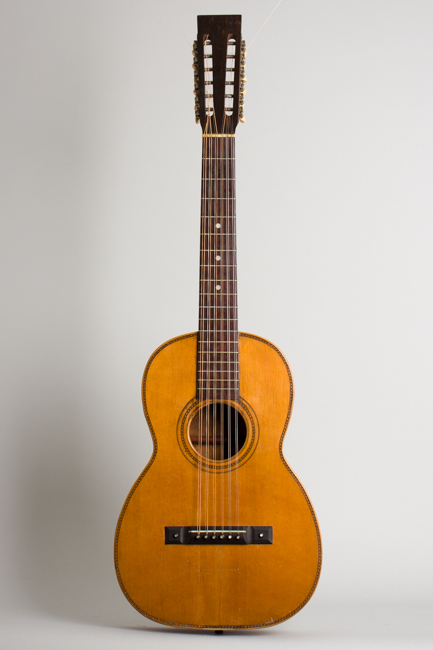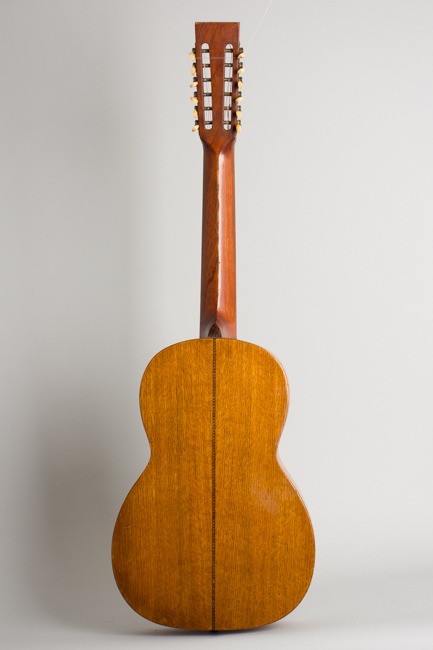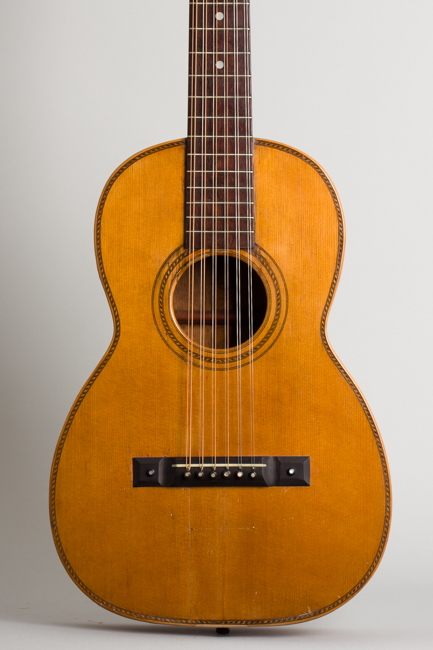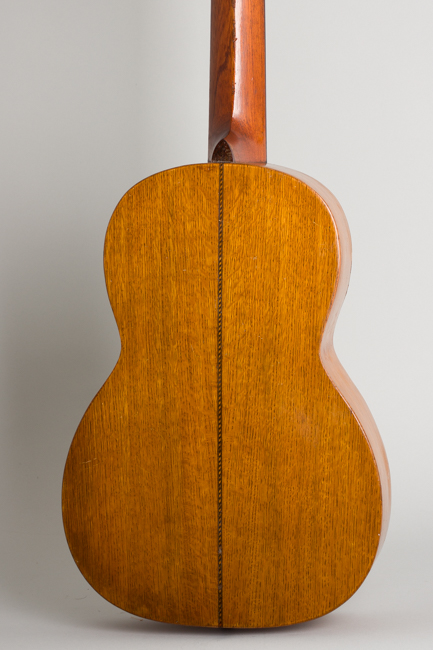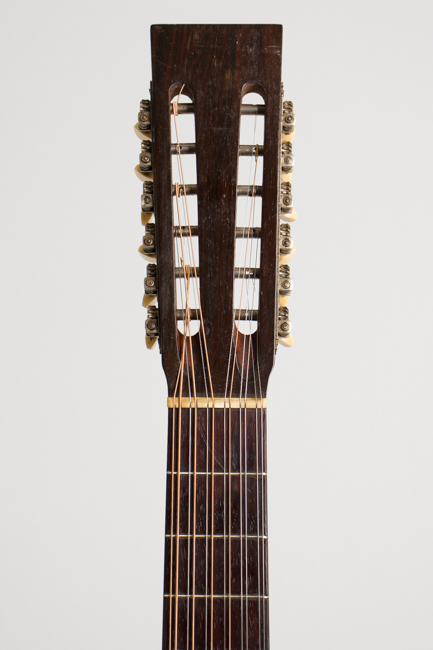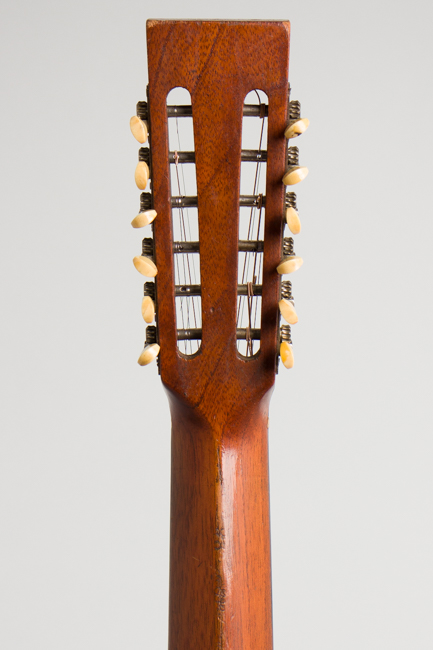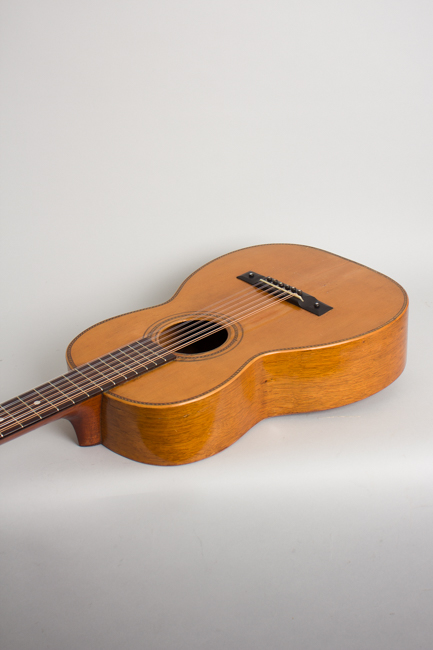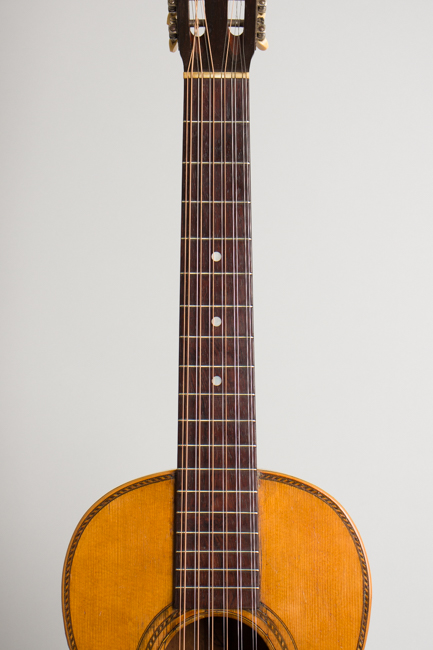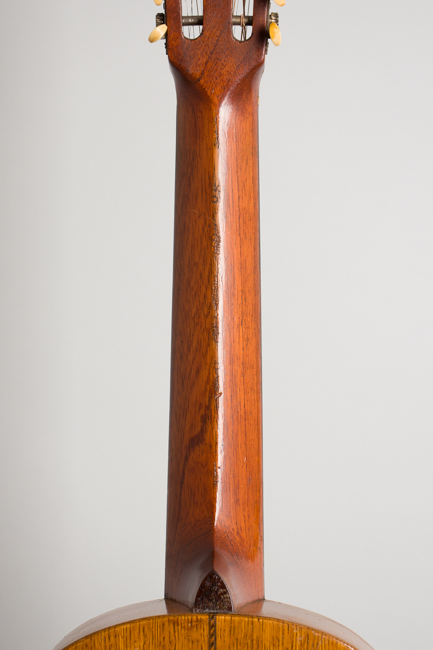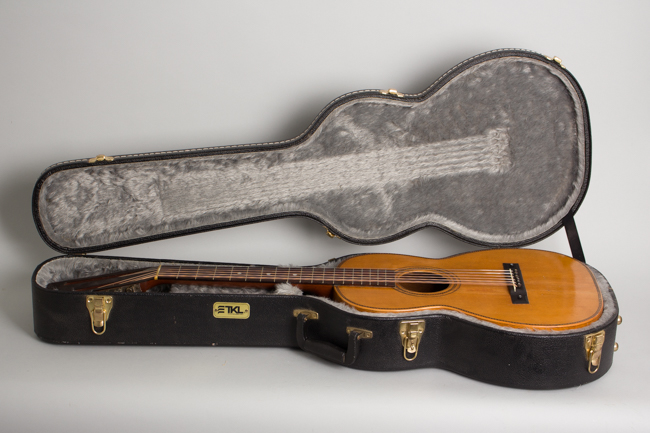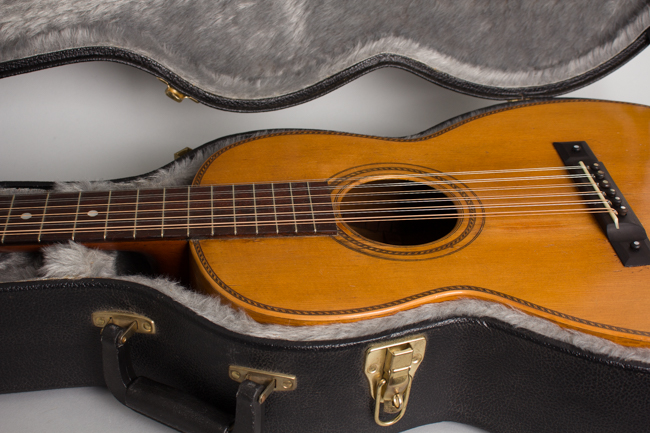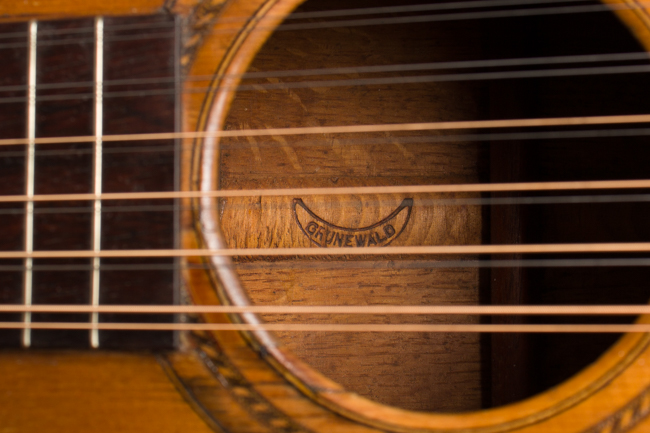Grunewald 12 String Flat Top Acoustic Guitar (1902)
This item has been sold.
Item # 11354
Prices subject to change without notice.
Grunewald 12 String Flat Top Acoustic Guitar (1902), made in New Orleans, LA, natural varnish finish, oak back and sides, spruce top; cedar neck with rosewood fingerboard, black hard shell case.
This diminutive double-coursed guitar is a spectacular and exceptionally rare piece of early 20th century American guitar history, and also a fabulous-sounding instrument. While this is a very small-bodied 12 string guitar, the tone is quite rich and complex. Grunewald guitars are a known part of the 1900-era fretted world but are exceptionally rare; only a few are known to exist. This is a generally very well preserved and original example, and among the very earliest 12-string guitars ever made. This exact style instrument was advertised in 1902, a successor to the earlier 10-string Grunewald patented and made as early as 1896.
The body is made from white oak; it is a small concert size at just 13" wide at the lower bout. The top is lovely tight-grained red spruce, bound in white holly and trimmed in half-herringbone marquetry. The sound hole is adorned with the same pattern and multiple purfling rings, as is the backstrip. The flat-ended pyramid bridge is Brazilian rosewood with six pin holes, the strings spaced with separator pins. There are two extra bridge pins centered in the flats of the bridge ends that serve no apparent function. These are shown in the Grunewald print ads from 1902, but no explanation is offered.
The surprisingly slim V-profile neck is carved from cedar, a wood common on guitars of this period. The slotted headstock face and heel are capped with Brazilian rosewood. The thick fingerboard is also Brazilian rosewood with slim early tang fretwire and three large pearl position dots. The nut is ivory or bone. The Handel tuners are similar to those used by Martin at the time, with lightly engraved baseplates and ivoroid buttons.
The guitar sports several hot-stamped Grunewald logos internally. In honor of the shop's home of New Orleans, these have a crescent symbol surrounding the name. According to early 1900s promotional copy for Grunewald's ten and twelve-strings, the point of the multi-course layout was not necessarily increased volume but rather ease of playing for an amateur guitarist. The idea was that with octave strings, most notes could be reached in the lower positions, rather than learning to play "up the neck".
With its short scale, low action and wide finger board, this little 12 has a sound that is jangly, but full, with enough bass from the deep body to round it out. It's a real pleasure to play, and is especially fun for any type of country blues or ragtime tunes but sounds at home in any style, vintage or modern. The small body reduces the "woofy" overtones often encountered, and this would make an exceptional 12-string for any recording purposes. Despite being almost completely obscure in American guitar history its aesthetic beauty, tone and historical significance rate this among the great 12-strings.
Overall length is 39 7/16 in. (100.2 cm.), 13 in. (33 cm.) wide at lower bout, and 3 13/16 in. (9.7 cm.) in depth at side, taken at the end block. Scale length is 24 3/4 in. (629 mm.). Width of nut is 2 1/16 in. (52 mm.).
Considering its age and relative fragility this rare guitar has survived very well, completely playable and wonderful sounding. The finish is very old; the topcoat is a somewhat sloppy oil varnish (by 1900 factory standard) and we cannot say for sure this is completely original, but if anything was added it was done MANY decades ago. That said, Grunewald instruments were built in small numbers in an obscure local shop and there is really little baseline for comparison. There is very little actual play wear, mostly just small dings, dents and scratches overall. The spine of the back of the neck has some capo wear into the wood, but nothing too distracting.
There are some old repairs, and some more recent. The area between the bridge and the edge of the top shows a sealed grain split behind the lowest string pair, and the center seam was resealed as well. Several small cracks were visibly but solidly repaired on the soundhole edge just below the fingerboard extension, running underneath the fingerboard to the heelblock. Most of these are neatly cleated underneath. There are no cracks in the back or sides.
The neck has been neatly reset, the original small frets dressed. The ebony bridge appears original, of at least a very well done repro, as it matches known period illustrations of this instrument perfectly, down to the two extra extension pins. At the very least it was reattached at some point. Internally the braces and large flat Stella-like bridgeplate are original and unaltered. The Tuner strips are original and still work well even 120 years on.
This is simply a super find, one of a very few Grunewald multi-coursed guitars known to exist in the 21st century. While a real museum piece in terms of historical importance, it is also a lovely guitar to play with a unique sound and feel never duplicated well over a century on. It resides in a well-fitted modern hard shell case. Overall Excellent - Condition.
This diminutive double-coursed guitar is a spectacular and exceptionally rare piece of early 20th century American guitar history, and also a fabulous-sounding instrument. While this is a very small-bodied 12 string guitar, the tone is quite rich and complex. Grunewald guitars are a known part of the 1900-era fretted world but are exceptionally rare; only a few are known to exist. This is a generally very well preserved and original example, and among the very earliest 12-string guitars ever made. This exact style instrument was advertised in 1902, a successor to the earlier 10-string Grunewald patented and made as early as 1896.
The body is made from white oak; it is a small concert size at just 13" wide at the lower bout. The top is lovely tight-grained red spruce, bound in white holly and trimmed in half-herringbone marquetry. The sound hole is adorned with the same pattern and multiple purfling rings, as is the backstrip. The flat-ended pyramid bridge is Brazilian rosewood with six pin holes, the strings spaced with separator pins. There are two extra bridge pins centered in the flats of the bridge ends that serve no apparent function. These are shown in the Grunewald print ads from 1902, but no explanation is offered.
The surprisingly slim V-profile neck is carved from cedar, a wood common on guitars of this period. The slotted headstock face and heel are capped with Brazilian rosewood. The thick fingerboard is also Brazilian rosewood with slim early tang fretwire and three large pearl position dots. The nut is ivory or bone. The Handel tuners are similar to those used by Martin at the time, with lightly engraved baseplates and ivoroid buttons.
The guitar sports several hot-stamped Grunewald logos internally. In honor of the shop's home of New Orleans, these have a crescent symbol surrounding the name. According to early 1900s promotional copy for Grunewald's ten and twelve-strings, the point of the multi-course layout was not necessarily increased volume but rather ease of playing for an amateur guitarist. The idea was that with octave strings, most notes could be reached in the lower positions, rather than learning to play "up the neck".
With its short scale, low action and wide finger board, this little 12 has a sound that is jangly, but full, with enough bass from the deep body to round it out. It's a real pleasure to play, and is especially fun for any type of country blues or ragtime tunes but sounds at home in any style, vintage or modern. The small body reduces the "woofy" overtones often encountered, and this would make an exceptional 12-string for any recording purposes. Despite being almost completely obscure in American guitar history its aesthetic beauty, tone and historical significance rate this among the great 12-strings.
Overall length is 39 7/16 in. (100.2 cm.), 13 in. (33 cm.) wide at lower bout, and 3 13/16 in. (9.7 cm.) in depth at side, taken at the end block. Scale length is 24 3/4 in. (629 mm.). Width of nut is 2 1/16 in. (52 mm.).
Considering its age and relative fragility this rare guitar has survived very well, completely playable and wonderful sounding. The finish is very old; the topcoat is a somewhat sloppy oil varnish (by 1900 factory standard) and we cannot say for sure this is completely original, but if anything was added it was done MANY decades ago. That said, Grunewald instruments were built in small numbers in an obscure local shop and there is really little baseline for comparison. There is very little actual play wear, mostly just small dings, dents and scratches overall. The spine of the back of the neck has some capo wear into the wood, but nothing too distracting.
There are some old repairs, and some more recent. The area between the bridge and the edge of the top shows a sealed grain split behind the lowest string pair, and the center seam was resealed as well. Several small cracks were visibly but solidly repaired on the soundhole edge just below the fingerboard extension, running underneath the fingerboard to the heelblock. Most of these are neatly cleated underneath. There are no cracks in the back or sides.
The neck has been neatly reset, the original small frets dressed. The ebony bridge appears original, of at least a very well done repro, as it matches known period illustrations of this instrument perfectly, down to the two extra extension pins. At the very least it was reattached at some point. Internally the braces and large flat Stella-like bridgeplate are original and unaltered. The Tuner strips are original and still work well even 120 years on.
This is simply a super find, one of a very few Grunewald multi-coursed guitars known to exist in the 21st century. While a real museum piece in terms of historical importance, it is also a lovely guitar to play with a unique sound and feel never duplicated well over a century on. It resides in a well-fitted modern hard shell case. Overall Excellent - Condition.
